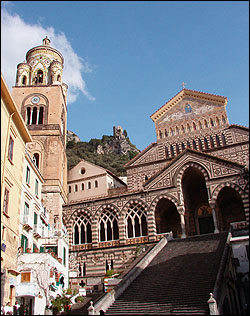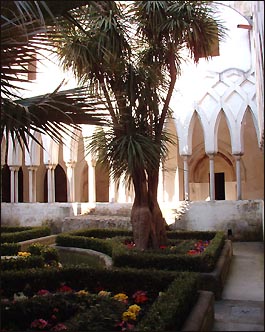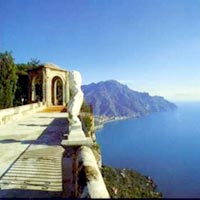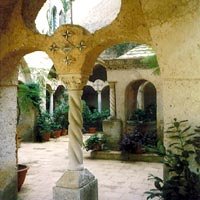The Saracens' Coast
The excursion to the Amalfi Coast (so called “Saracens’ Coast”) will start at 8,40 a.m. with the transfer by ferry from Salerno to Amalfi (35 minutes) to enable the participants to enjoy the wonderful view of the coast by the sea.
Then the group will visit Amalfi: the cathedral dedicated to S. Andrew, the crypt, the Paradise Cloister and the medieval dockyards; afterwards a pleasant walk through the ancient whitewashed alleys will lead the participants in the heart of the village till the Mills’ Valley, where they will able to visit the Paper Museum, the old paper mills (producing the typical and very precious “Amalfi paper”) and the iron-foundries.

After a lunch with typical dishes in Pogerola, a beautiful hamlet on the slopes, the group will reach Ravello by bus and then visit the cathedral, Villa Rufolo and Villa Cimbrone.
The return to Salerno by ferry is scheduled at 7.p.m.
Read below to learn more about Amalfi and Ravello.
Amalfi, the Sea Republic
No wonder that this magnificent piece of coast bears the name of this village: Amalfi is doubtlessly the most important centre and, we should add, it is since over 1000 years ago.
Amalfi flourished in Middle Age, thanks to the initiative and the courage of its tradesmen, who boldly ventured to Asia Minor and to Africa to buy luxury goods to be sold in the markets of all the south of Italy and the rest of the peninsula. Amalfi’s merchants warehouses were in every important harbour of the Mediterranean Sea.
Amalfi was a miracle created by commerce and once you realise how small the city was you won’t cease to wonder when you learn that for centuries it competed with the other Italian Sea Republics, Venice, Genoa and Pisa which were much bigger for number of inhabitants and for their territories.

The contacts with different cultures enabled Amalfitans to introduce in western Europe fundamental instruments for navigation, like the compass (whose invention was also attributed to the amalfitan navigator Flavio Gioia), and many scientific notions learned from the Arabs.
The influence of overseas cultures is extremely clear also the monuments of Amalfi, especially in the cathedral dedicated to S. Andrew, in the Paradise’s Cloister with its Arabian crossed arches, and in the alleys and galleries of the ancient city.
Amalfi is nowadays a touristic place and a sea resort where you can find art, culture, gastronomy and traditions, like the Sea Republic regatta held every year in turns in one of the Sea Republic and the procession of S. Andrew.
Ravello, the city of music
Ravello is one of the most ancient villages in the Amalfi coast: it was founded in the VI century by aristocratic roman families who wanted to find shelter from Saracens and barbarians who ravaged the coast. It lays on a spur 350 meters above the sea, so dominating the sea and enjoying a wonderful view over the coast.
The village reached splendour in XIII century thanks to the flourishing trades the merchants made with the Eastern Mediterranean through Amalfi. From the Middle age we still can see the Church of S. Giovanni del Toro, built in 975 a.C. by the local noble families in the quarter called “Toro”, with a magnificent mosaic ambo, and the Cathedral, built in 1086, with its bronze doors, mosaic pulpit and ambo.

Probably Ravello is even more famous for its villas. Villa Rufolo was built in the XIII century and is beautiful example of the influences of the Arabian architecture during the Norman period in the south of Italy. Its gardens enchanted Richard Wagner and made him say “Here is the magic garden of Klingsor!”, in fact this is the place which inspired him the composition of his “Parsifal”. Villa Rufolo is remembered also in a masterpiece of literature, in Giovanni Boccaccio’s Decameron, in which it is said to be the place where the women and three young men met to tell the one hundred tales. The vertiginous view from the terrace of the garden is the background of the annual festival of classical music dedicated to Wagner. The Ravello Concert Society is in fact very active and every year provides very rich programme of concerts performed by the most important musicians and attended by aficionados from all over the world.

Villa Cimbrone has recent origins but is equally beautiful. Its story begins when a tailor from Ravello, emigrated in England, talked with Lord Beckett about the most panoramic site in Ravello, a piece of land called "Cimbrone". Lord Beckett bought the land and the ex tailor, become the keeper of the property, with the help of local workers, transformed the land in a very characteristic and fascinating villa. We can admire the little cloister with a well and a portico, a watch tower built in the style of Villa Rufolo and enclosed in a sort of little castle. Villa Cimbrone hosted famous scientists, artists, politicians and actors like Greta Garbo. The interiors are rich in statues, relieves, ancient furniture, and paintings. Many wonderful spots are disseminated in the garden, like the Temple of Cerere, the grotto of Venus, the statue of Hermes, and the amazing terrace of the Infinite, suspended between the sky and the sea and embellished by the busts of the Seven Kings of Rome. Villa Cimbrone is property of Vuillemier family, whose latest descendant is now a Rotarian.
All this and a lot more you will see in Ravello!